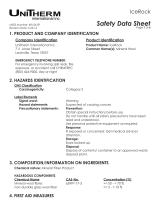Page is loading ...

MATERIAL SAFETY DATA SHEET WCTA200A
This MSDS complies with OSHA'S Hazard Communication standard 29 CFR 1910.1200 and OSHA Form 174
IDENTITY AND MANUFACTURER'S INFORMATION
NFPA Rating: Health-2 Flammability-0 Reactivity-0 Special--- HMIS Rating: Health-2 Flammability-1 Reactivity-0 Personal Protection-B
Manufacturer's Name: DYNAFLUX, INC.
DOT Hazard Classification: Consumer Commodity ORMD 48580 Sub 3
241 Brown Farm Rd.
Identity (trade name as used on label):
Cartersville, GA 30120 LINCOLN ELECTRIC ANTISPATTER
Manufactured for: WCTA, LLC Gainesville, GA 30504
Prepared By: GS MSDS Number: WCTA200A Revision: 4/13/2010
Information Calls: (800)334-4420 NOTICE: JUDGEMENT BASED ON INDIRECT TEST DATA
Emergency Response Number: CHEMTEL US: (800)-255-3924 / International: 813-248-0585
SECTION 1 - MATERIAL IDENTIFICATION AND INFORMATION
COMPONENTS-CHEMICAL NAMES AND COMMON NAMES CAS SARA OSHA PEL ACGIH Carcinogen
(Hazardous Components 1% or greater; Carcinogens 0.1% or greater) NUMBER III LIST (PPM) TLV (ppm) Ref. source*
Dichloromethane >94% by wt. 75-09-2 YES 25 5 IARC NTP
Carbon Dioxide 124-38-9 NO 5000 5000 d
VOC = 0%
SECTION 2 - PHYSICAL/CHEMICAL CHARACTERISTICS
Boiling Point: 104° F Specific Gravity (H2O=1): 1.37
Vapor Pressure:(PSIG @ 70° F (Aerosols): 80 Vapor Pressure:(Non-Aerosols)(mm Hg and Temperature): 340 @ 20°F
Vapor Density:(Air=1):
2.93
Evaporation Rate (BUAC=1): 14.5
Solubility in Water: Insoluble Water Reactive: None
Appearance and Odor: White tinted fluid with hydrocarbon odor
SECTION 3 - FIRE AND EXPLOSION HAZARD DATA
FLAMMABILITY as per USA FLAME Auto Ignition Temperature Flammability Limits in Air by % in Volume:
PROJECTION TEST (aerosols) Non-Flammable 999° F %LEL: 13 %UEL: 23
FLASH POINT AND METHOD USED
(non-aerosols):
NA EXTINGUISHER MEDIA: Water fog; Carbon dioxide
SPECIAL FIRE FIGHT PROCEDURES: Spray containers with water fog to prevent rupturing.
Unusual Fire & Explosion Hazards: Do not expose aerosols to temperatures above 120 ° F as container may rupture.
SECTION 4 - REACTIVITY HAZARD DATA
STABILITY: [x] STABLE [ ] UNSTABLE HAZARDOUS POLYMERIZATION [ ] WILL [ x ] WILL NOT OCCUR
Conditions to Avoid:
None Known
Incompatibility (Mat. to Avoid):Sodium, potassium & magnesium metals
Hazardous Decompositon Products:
Carbon dioxide, carbon monoxide and small amounts of hydrogen chloride and phosgene.
SECTION 5 - HEALTH HAZARD DATA
PRIMARY ROUTES OF ENTRY: [ X ] INHALATION [ ] INGESTION [ ] SKIN ABSORPTION [ ] EYE [ ] NOT HAZARDOUS
ACUTE EFFECTS:
Inhalation: Headaches, dizziness, nausea, respiratory irritation
Eye contact:
Redness and watering of the eyes; eye irritant.
Skin contact:Possible mild irritation due to defatting of skin by the chlorinated solvent.
Ingestion: Nausea, possible aspiration pneumonitis if vomited.
CHRONIC EFFECTS: Skin and eye irritant.
Medical conditions Generally Aggravated by Exposure:
Irregular heart beat
Carcinogenicity: Methylene Chloride has been shown to increase the rate on spontaneously occurring malignant tumors in laboratory mice and
benign tumors in laboratory rats. It is not believed to pose a measurable carcinogenic risk to man when handled as recommended.
It has been listed as a possible carcinogen by IARC and NTP.
EMERGENCY FIRST AID PROCEDURES
Eye Contact:
Flush with water for fifteen minutes. Get medical attention.
Skin Contact: Wash with soap and water. See physician if irritation develops.
Inhalation:
Primary route of exposure. Remove to fresh air. Resuscitate if necessary.
Ingestion: Unlikely route of exposure. Do Not Induce Vomiting. Call a physician.
SECTION 6 - CONTROL AND PROTECTIVE MEASURES
Respiratory Protection (specify type): In closed area use NIOSH approved positive air respirators.
Protective Gloves: Rubber gloves recommended.
Eye Protection: Safety Glasses
Ventilation Requirements: Adequate to keep vapor conc. below TLV.
Other Protective Clothing & Equipment:
None
Hygienic Work Practices: Wash hands before handling food.
SECTION 7 - PRECAUTIONS FOR SAFE HANDLING AND USE
Steps To Be Taken if Material Is Spilled Or Released:
Small spills, mop up, wipe up or soak up immediately. Large spills, transfer to closed metal containers. Keep out of water supply.
Waste Disposal Methods: Aerosol cans, when vented to atmospheric pressure through normal use pose no disposal problem.
Precautions To Be Taken In Handling & Storage:
Avoid breathing vapors. Do not puncture or incinerate container. Do not store at temperatures above 120° F.
Other Precautions &/or Special Hazards: KEEP OUT OF REACH OF CHILDREN.
We believe the statements, technical information and recommendations contained herein are reliable, but they are given without warranty
or guarantee of any kind.
*Chemical Listed as Carcinogen or Potential Carcinogen. [a] NPT [b] IARC Monograph [c] OSHA [d] Not Listed [e] Animal Data Only
/




